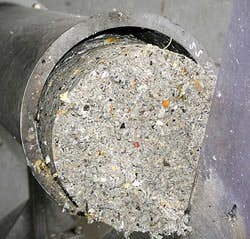Compactor Cleans Up in Seattle
In 2004, a team of researchers from Washington state’s King County Wastewater Treatment Division took on the task of cleaning up problems with the discharged screenings at their two treatment plants. The screenings were filled with excessive water, fecal and other organic matter.
The local landfill even put restrictions on the time and place screenings were unloaded because of the high fecal content. The landfill dug special pits before the screenings could be dumped, then would immediately cover them. The research team was concerned the restrictions might one day impact plant operations.
“There were several issues we looked at,” said Curtis Steinke, a process analyst for King County and member of the research team. “First, we looked at the SWM’s ability to provide additional dewatering and removal of fecal matter. Second, we compared its performance to our current screening compacter unit, which lacked a grinder.”
South Plant’s screening system consists of bar screens with 3/8-in. (10-mm) openings that remove trash and rags from the average daily flow of 78 million gal (3,417 liters per second). The screenings are pumped to a washing and compacting unit, which is supposed to wash, clean and dewater the screenings. However, the unit often was overloaded and discharged screenings containing a high amount of bound water.
“The old washer-compactor passed the paint filter test but didn’t pass the stack test,” Steinke said. “The product coming off the old compactor acted like a sponge. As the screenings piled up in the dumpster, the weight of the material on top would squeeze the bound water out of material on the bottom. By the time the dumpster was full, there could be 100 gal (375 liters) of free water sloshing inside each trailer load, which caused hauling and disposal issues.”
Full-scale testing of the SWM showed a reduction of 8 wet tons of screenings per week, an almost 60% reduction from the previous volume. The team estimated yearly haul and disposal savings of roughly $40,000.
“Economically, we reduced our hauls (to the landfill) from twice a week to once a week,” Steinke said. “And our tons disposed of dropped from 14 wet tons down to 6 tons—a significant reduction, thanks to the SWM.”
The washer uses a patented process to break up entrained fecal matter and produce a cleaner, drier final product. The first spray wash flushes screenings into a Macho Monster grinder where material is broken up and surface area is exposed to a second spray wash that liquefies more fecal matter, allowing it to flow through a perforated trough and back into the plant flow. An auger then compresses and dewaters the washed material, pushing it up and out a vertical discharge tube. The cleaned screenings then drop into a trailer ready for landfill disposal.
“It’s the grinding that helps get cleaner screenings,” Steinke said. “We thought our screenings had minimal fecal matter, but after watching the grinder attack the screenings and turn the wash water to the color of chocolate milk, we knew better. It turns out fecal/organic matter was bound inside of paper products, which the team nicknamed ‘breakfast burritos.’ The grinder was able to liquefy the organics wrapped up inside the ‘breakfast burritos’ and return it back to the plant for treatment.”
After two years of operation at South Plant, the SWM continues to produce clean and dry screenings. Relations with the local landfill have also improved, allowing the trailers to be emptied whenever needed. According to Kenneth Eldridge, mechanical lead at South Plant, the grinder has needed maintenance twice.
The trial unit differed slightly from the unit eventually installed at South Plant. The installed unit uses a finer 1/8-in. (3-mm) perforated screen and the discharge tube was rotated 45 degrees from vertical in order to fit into the available space. On average, the installed unit is producing a 40% savings compared to the old system. The research team is looking to extend the discharge tube 12 in. (300 mm) to produce even drier screenings.
Both Eldridge and Steinke recommend the SWM to other treatment plants in the King County system both for the cleanliness and the savings.
